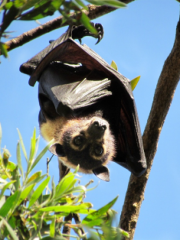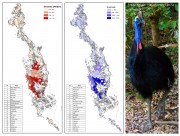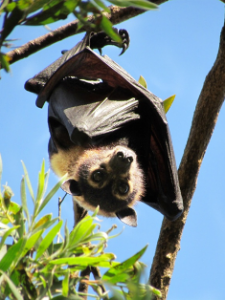NERP TE Project 3.4 - Monitoring of key vertebrate species (CSIRO)
Project summary
Monitoring of cassowaries and spectacled flying foxes provides valuable information on population sizes and trends, the distribution of their populations, their habitat requirements, and threats to their survival.
The project will:
- Improve monitoring methods for endangered species;
- Update data on cassowary abundance and distribution;
- Determine the size of and distribution of the flying fox population; and
- Inform decision makers in agriculture, urban planning and biosecurity
Why this research is needed
Up-to-date information on population size and distribution of the vulnerable spectacled flying fox and the endangered cassowary is vital to managing and conserving these unique species. These species are considered indicators of rainforest health.
Research-user focus
This project will assist local, state and Australian government bodies, particularly the Department of Sustainability, Environment, Water, Population and Communities (SEWPAC), Queensland Parks and Wildlife Service (QPWS), Cairns Regional Council, Far North Queensland Regional Organisation of Councils (FNQROC), and Terrain NRM in assessing the need for management action and the efficacy of their management actions.
Outcomes
- Estimates of cassowary population size, distribution and structure will provide a baseline for cassowary conservation efforts;
- Estimates of the abundance of cassowaries in different vegetation types which will enable the assessment of the value of different habitats and the potential impacts of proposed projects, natural disturbances and climate change; and
- Reports on the size and distribution of flying-fox populations, locally and regionally to aid management decisions.
The project will assist in assessing the need for management action and the efficacy of their management.
Reports, Publications and News
For more information see Project 3.4 'Monitoring of key vertebrate species' on the NERP Tropical Ecosystems Hub site.
Datasets

This data set shows the occupancy and size of spectacled flying-fox camps across the distribution of the spectacled flying-fox in the Wet Tropics Region. Camp locations are also provided. Data was collected monthly and all camps in the region were monitored each month.

This dataset contains the estimated distribution and abundance of cassowaries across the Wet Tropics Region and the sub-regions used in these estimates. The key areas for cassowary conservation are those with the highest densities and abundance.
This data is based on field surveys and data on cassowary density derived from faecal-DNA analysis of dung samples collected during those surveys.
Methods:
This project will implement monitoring programs for the endangered southern cassowary, Casuarisus casuarius, and the vulnerable spectacled flying-fox, Pteropus conspicillatus.
Cassowary monitoring will be based on regular surveys to collect dung. DNA fingerprinting of the bird dung will provide data on cassowary abundance and distribution, the influence of habitat type and the structure and phylogeography of cassowary populations across the region.








